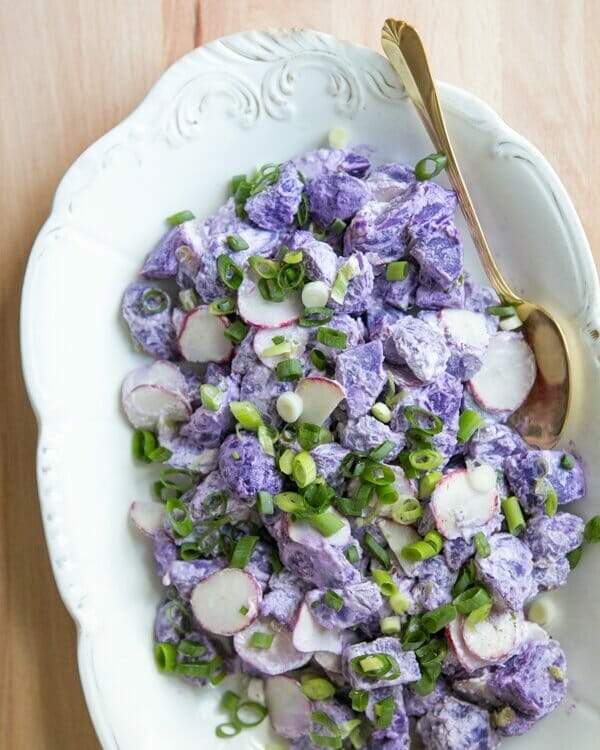Got purple potatoes? These brilliant violet spuds always catch our eye at the grocery store or farmer’s market. Their lovely hue remains even when they’re cooked, making them a fun way to mix up the typical mashed potatoes or potato salad. While their flavor is similar white and yellow potatoes, they’ve got even more antioxidants and are better for blood sugar. What’s not to love? Here’s a bit more about purple potatoes and our favorite ways to use them (what’s better than a fluffy pile of purple mash?).
What are purple potatoes?
Purple potatoes are a type of potato that is purple in color, both when raw and cooked. There are close to 4,000 varieties of potatoes in the world; the purple type range in hue from bright violet to dark purple black. Some common varieties of purple potatoes are Purple Peruvian, Purple Majesty, All Blue, Congo, Adirondack Blue, Purple Fiesta, and Vitelotte. Despite their vibrant color, purple potatoes taste essentially the same as yellow or red potatoes: they have a delicate, earthy flavor. You can prepare them in the same way as any other potato: baked, roasted, mashed, fries, potato salad, and more.
Buying and storing purple potatoes
What to look for when you’re buying purple potatoes at the store? Here’s what to know:
Choose purple potatoes that are firm and round, with no noticeable blemishes or bruises. They are available at most supermarkets and often at farmers markets. Keep the potatoes in a cool, dry, well ventilated place. It’s best to store potatoes in a dark area of your pantry or basement, ideally between 40 to 50°F. Stored properly, potatoes should last for 1 to 2 months. Don’t store potatoes under your sink! Potatoes thrive in dark, moist environments, so avoid storing them under the sink where they will quickly grow and sprout because of the moisture.
Purple potato nutrition
Purple potatoes are a nutritious food that is full of nutrients in the skin and flesh. Here are a few of the notable nutrition facts (source):
One 3.5 ounce serving of purple potatoes includes 3 grams of fiber and nutrients, including Vitamin C, Vitamin B, copper, potassium, and more. Purple potatoes have a lower glycemic index than white potatoes, meaning they are better for blood sugar. Glycemic index (GI) measures how much food raises your blood sugar, ranging from 0 to 100 (with 70 being considered high). A study found that purple potatoes have a GI of 77, compared to white potatoes at 93 and yellow potatoes at 81. Purple potatoes have 2 to 3 times the antioxidants in white and yellow potatoes. Antioxidants can protect your cells from damage.
Purple potato recipes
What to make with purple potatoes? This root vegetable is extremely versatile, and works roasted, mashed, in potato salad, fried, and more! No reviews











